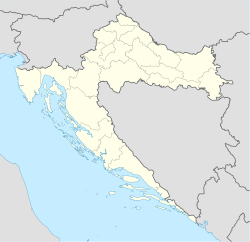Barban
Barban
Barbana, Barbon | |
|---|---|
Municipality | |
| Barban Municipality Općina Barban | |
 Location of Barban municipality in Istria | |
 | |
| Coordinates: 45°06′N 14°01′E / 45.100°N 14.017°E | |
| Country | |
| County | |
| Government | |
| • Municipal mayor | Dalibor Paus (IDS) |
| Area | |
• Municipality | 90.5 km2 (34.9 sq mi) |
| • Urban | 4.0 km2 (1.5 sq mi) |
| Elevation | 229 m (751 ft) |
| Population (2021)[2] | |
• Municipality | 2,491 |
| • Density | 28/km2 (71/sq mi) |
| • Urban | 218 |
| • Urban density | 55/km2 (140/sq mi) |
| Time zone | UTC+1 (CET) |
| • Summer (DST) | UTC+2 (CEST) |
| Postal code[3] | 52207 Barban |
| Area code | 52 |
| Website | barban |
Barban (Italian: Barbana, Čakavian Barbon, or Brban) is a small town and municipality in the southern part of eastern Istria, Croatia.
The municipality of Barban covers an area of around 100 km2 and contains 23 settlements with a total of 2,491 people.
History
[edit]The site of a Bronze Age prehistoric hill fort, human remains have been found on the site that dates back approximately 3,400-4,000 years back. The name Barban appears for the first time in an ecclesiastic document dated 740 A.D. In the Middle Ages, the town was fortified while under control of feudal lords from Pazin, and parts of those medieval fortifications can still be seen. In the second half of the 13th century, having been depopulated by the plague in 1312, a small colony of Dalmatians from Finodol settled in the area, brought by the counts of Gorizia.
In 1374, upon the death of Albert IV, Count of Pazin, it became a full Habsburg possession, before being taken over by the Republic of Venice in the 16th century. The Loredan noble family bought Barban from the counts in Pazin in 1535. [4]
In the main square, which is reached by passing through Velika Vrata (the Great Gate, 1718), stands the St. Nicholas parish church with baroque altars and paintings by Venetian masters from the 16th-18th centuries, a Late Gothic stone tabernacle, and wooden baroque sculptures.
Demographics
[edit]In 2021, the municipality had 2,491 residents in the following 23 settlements:[2]
- Barban, population 218
- Bičići, population 69
- Borinići, population 5
- Draguzeti, population 75
- Glavani, population 77
- Grandići, population 122
- Hrboki, population 159
- Jurićev Kal, population 44
- Koromani, population 50
- Kožljani, population 49
- Manjadvorci, population 165
- Melnica, population 175
- Orihi, population 101
- Petehi, population 90
- Prhati, population 135
- Puntera, population 67
- Rajki, population 6
- Rebići, population 118
- Rojnići, population 47
- Sutivanac, population 333
- Šajini, population 175
- Vadreš, population 56
- Želiski, population 155
| population | 2123 | 2614 | 2771 | 2745 | 2932 | 3418 | 3899 | 4320 | 4300 | 4291 | 4107 | 3561 | 3014 | 2983 | 2802 | 2721 | 2491 |
| 1857 | 1869 | 1880 | 1890 | 1900 | 1910 | 1921 | 1931 | 1948 | 1953 | 1961 | 1971 | 1981 | 1991 | 2001 | 2011 | 2021 |
In 2011, out of 2,721 people, 75% were Croats. The town of Barban itself had a population of 221.[5]
Prstenac tournament
[edit]
An equestrian tournament, known as Trka na prstenac and very similar to Sinjska alka, is held in Barban on the third Sunday in August. It is a medieval jousting game that goes back to 1696 in Barban, but it is much older in origins and is otherwise celebrated in various forms in several medieval towns in Italy today. This tradition draws tourists and spectators in great numbers in a lively and popular celebration.
References
[edit]- ^ Register of spatial units of the State Geodetic Administration of the Republic of Croatia. Wikidata Q119585703.
- ^ a b "Population by Age and Sex, by Settlements" (xlsx). Census of Population, Households and Dwellings in 2021. Zagreb: Croatian Bureau of Statistics. 2022.
- ^ List of Croatian settlements and delivery post offices. Wikidata Q125763583.
- ^ "ISTRA.HR". www.istra.hr (in Croatian). Retrieved 2023-04-26.
- ^ "Population by Ethnicity, by Towns/Municipalities, 2011 Census: County of Istria". Census of Population, Households and Dwellings 2011. Zagreb: Croatian Bureau of Statistics. December 2012.
Sources
[edit]This article includes a list of references, related reading, or external links, but its sources remain unclear because it lacks inline citations. (September 2011) |
- Trka na prstenac (in Croatian)
External links
[edit]- Official website (in Croatian)
- Town of Barban at Istrianet.org



